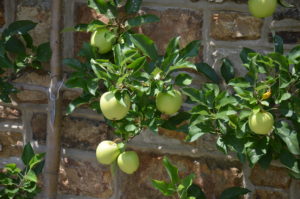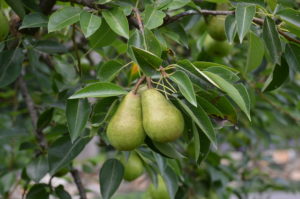Why trees fail to bear fruit or only produce fruit every other year? There are 8 common reasons:
- Excessive Tree Vigor – Primary cause is over-fertilizing and/or over-pruning fruit trees. Heavy applications of nitrogen will stimulate excessive growth at the expense of flower production. A nearby fertilized lawn may supply too much nitrogen to adjacent fruit trees. Heavy winter pruning also stimulate excessive growth. Apple and pear trees are pruned differently than peach, plum, and cherry trees.
- Frost Damage – Late spring frosts or temps below 30 °F will damage flower parts. Do not plant fruit trees in low land areas. Fruit trees bloom at different times in the spring. Early flowering apricots are frequently damaged by spring frosts. Peaches bloom first before cherries, plums, pears, peaches and apples (last). Apple varieties flower at different times, such as Gala and MacIntosh bloom before Rome Beauty.
- Severity of winter temperatures. Extremes in temperatures over winter months can damage dormant flower buds. Areas where winter temperatures consistently drop below -15 °F will not support consistent fruit production. Flower bud hardiness (most hardy to least cold hardy): Pears > Apple > Apricots > Tart Cherries > Sweet Cherries > Plums > Peaches > Nectarines.
- Poor Pollination by Bees – Weather factors like rain or high winds will reduce bee activity and pollination. Improper spraying of pesticides will also reduce bee populations. Avoid the use of insecticides during bloom that may kill honeybees.
- Cross vs Self-Pollinated – Apples, pears and sour cherries must be cross pollinated for maximum fruit crops. Plant 2 or more different varieties for optimum fruit set. Peaches, nectarines, tart cherries and most plums are self-fruitful and only one variety is necessary to produce fruit.
- Over-production – Heavy crops the previous year, particularly apple and pear trees, can reduce shoot growth and/or prevent flower formation. Remove some fruits by hand within one month after petal fall. With apples and pears, thin to 1 to 2 fruit cluster per 6 to 10 inches of branch length. Heavy crop loads on peach and nectarine trees reduce shoot growth and less fruit buds will form the following year. With peaches and nectarines, thin to one fruit per 10 inches.
- Tree age – Apples and pears should not bear fruits until 3-4 years after planting (depending on rootstock). For example, apple varieties are grafted on semi-dwarf rootstock like M111 or EM7.
- Sevin™ (Carbaryl), sprayed on apple and pear trees when they’re flowering or within first month after petal fall, will cause some or all fruits to drop. Read the label of pesticides to avoid unintentional thinning of the fruit.



 Posted in
Posted in 
